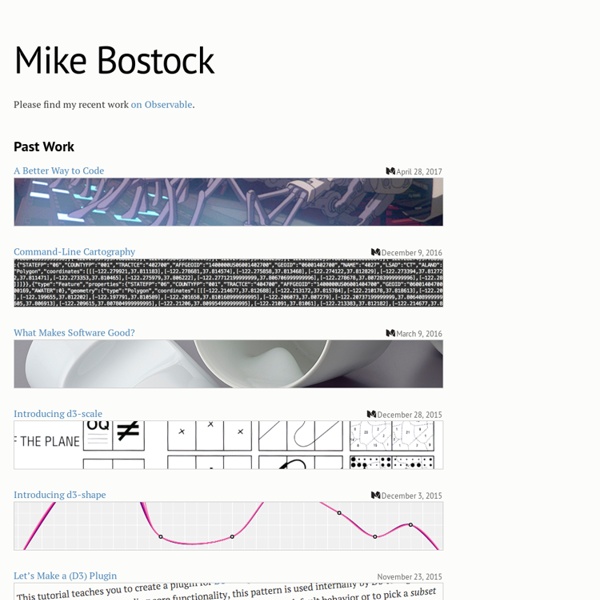d3.js
Cube
Time Series Data Collection & Analysis Cube is a system for collecting timestamped events and deriving metrics. By collecting events rather than metrics, Cube lets you compute aggregate statistics post hoc. It also enables richer analysis, such as quantiles and histograms of arbitrary event sets. Cube is built on MongoDB and available under the Apache License on GitHub. Collecting Data An event in Cube is simply a JSON object with a type, time, and arbitrary data. Cube’s collector receives events and saves them to MongoDB. Querying Events Cube defines a simple language for querying events. You can intersect filters and customize which event fields are returned. request(browser).gt(duration, 250).lt(duration, 500) Cube supports both HTTP GET and WebSockets for retrieving events. Querying Metrics You can also use Cube to group events by time, map to derived values, and reduce to aggregate metrics. The first few results of which appear as: sum(request.eq(path, "/search")) sum(request(duration))
TextMate — The Missing Editor for Mac OS X
byjess.net
8 Best CSS Sprites Generator Resources
CSS sprites are a way to reduce the number of HTTP requests made for image resources referenced by your site. Images are combined into one larger image at defined X and Y coordinates. Having assigned this generated image to relevant page elements the background-position CSS property can then be used to shift the visible area to the required component image. Today we have list 8 best css sprite resources. Nav-o-Matic Simply upload your navigation sprite below, add some guides, name some stuff and hey presto! Css Sprites Upload your image, add more than one image and create your sprite, You could also set your output type as PNG, JPEG or GIF. CSS Sprites Upload any number of images and just hit the Generate button to create your CSS sprite. Spritebox CSS Sprite Generator CSS Sprite Generator Choose your set of images to be combined into a CSS sprite, customize the background colors and order the images in your way and get the final job done. Canvas CSS Sprites CSS Sprites
O'Reilly Radar - Insight, analysis, and research about emerging technologies
The Industry - Thoughts on Flash
Since Steve Jobs posted his "Thoughts on Flash" in April 2010, a lot has been talked about with regards to the future of Flash. With Adobe's recent announcement that "Our future work with Flash on mobile devices will be focused on enabling Flash developers to package native apps with Adobe AIR for all the major app stores. We will no longer continue to develop Flash Player in the browser to work with new mobile device configurations (chipset, browser, OS version, etc.) following the upcoming release of Flash Player 11.1 for Android and BlackBerry PlayBook. I contacted 50 of the top FWA award winning agencies and asked them: "After Adobe's announcement of no more Flash player dev on mobile browser and the hysteria it is whipping up, I thought it would be a good idea to get some thoughts from the people that actually make the work." Here's what they had to say... Joshua Hirsch, Partner & Minister of Technology, Big Spaceship Petter Westlund, CCO, B-Reel Too Big To Fail? Steve Jobs.
A Step-by-Step Guide to Leaving Your Big Predatory Bank - Politics
A major goal of the Occupy Wall Street protest that's been happening in New York City for nearly a month is to teach the banks that ruined America a lesson. The financial industry's pursuit of money at all costs is a large part of why the United States is suffering today, but their "too big to fail" power is so intimidating as to confuse people wondering how to punish them for their unethical practices. Bank Transfer Day may be the solution everyone is looking for. Bank Transfer Day is a grassroots effort to get anyone upset with large predatory banks to move their money to nonprofit credit unions by Saturday, November 5. Because completely shifting your finances can be a daunting task, communications firm Fearless Revolution has come up with a detailed step-by-step guide to leaving your big bank and joining a credit union. Photo via (cc) Flickr user aflcio
Clarifications on Flash Player for Mobile Browsers, the Flash Platform, and the Future of Flash at Mike Chambers
I have worked with Flash and been part of the Flash community for about 12 or 13 years (over 10 of those with Macromedia and Adobe). Over that time there have been a lot of ups and down, but I think that the past couple of days have been some of the most difficult of my career. I wanted to make a post which will hopefully clarify some of the news from the past couple of days, and provide some more context around what is going on. <!--more--> First, and foremost, a couple of days ago Adobe announced the following: We are focusing work around the Flash Platform on: Mobile Applications created with Adobe AIR. It is this last point which received the most attention, caused the most confusion, and essentially overshadowed all of the other information. So, please bear with me as this may up being a long post, but I want to talk about the why, as well as discuss what we see as the role of Flash on the web (especially in relation to HTML5). Just to be very clear on this. Adobe AIR Adobe Flex
Treesaver | Design for reading



